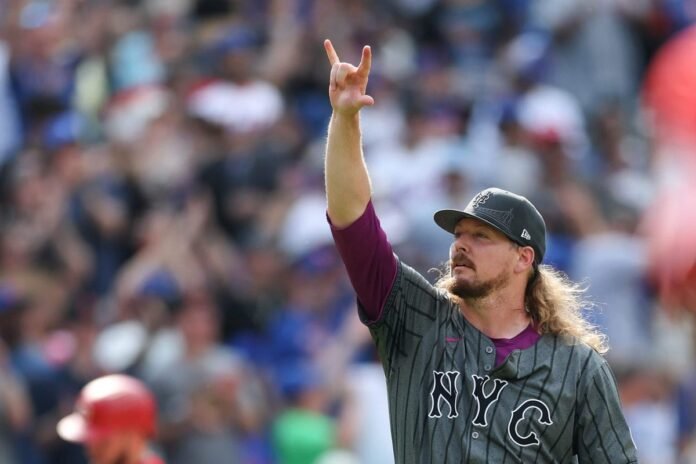With approximately a week and a half left before the MLB trade deadline, rival evaluators say they admire the New York Mets’ farm system, noting its improvement, quality and depth.
It is deep in terms of sought-after pitchers and up-the-middle position players.
What the industry is eager to learn: How much are the Mets willing to subtract from it in order to address major-league needs?
Beyond their farm system, the Mets are willing to deal from their major-league infield depth, league sources said. They have four young infielders in Mark Vientos, Brett Baty, Ronny Mauricio and Luisangel Acuña all vying for playing time at third base and second base when Jeff McNeil plays center field. With limited opportunities — obviously stars Francisco Lindor and Pete Alonso are locked into shortstop and first base, respectively — it would only make sense for the Mets to have conversations with other clubs about their younger infielders if it means helping them elsewhere, whether that’s in the lineup or on the mound.
Though the Mets (56-44) have other flaws, their main priority is supplementing their bullpen. They need multiple relievers. Their preference is to find help through trades.
If New York somehow does not find a deal to its liking that meaningfully improves its bullpen, the Mets are open to using top starting pitcher prospects Nolan McLean, Brandon Sproat and Blade Tidwell in shorter roles in the majors, people briefed on their plans said. The Mets don’t appear to be committing to such a decision, but it is among the possibilities.
Mets president of baseball operations David Stearns used a similar strategy in the past. While with the Milwaukee Brewers, he broke in future top starters Brandon Woodruff, Corbin Burnes and Freddy Peralta as relievers for teams in playoff hunts. However, there is more risk in going such a route compared to acquiring a proven reliever.
Industry sources expect the bullpen market to feature many options. The level of quality at the top remains unclear. Pittsburgh Pirates closer David Bednar, who isn’t a free agent until after the 2026 season, is available. It is still up in the air as to whether other closers under club control, such as the Cleveland Guardians’ Emmanuel Clase, the Athletics’ Mason Miller, the Minnesota Twins’ Jhoan Duran and the Baltimore Orioles’ Félix Bautista, join Bednar on the market. Such impactful relievers are also relatively affordable, meaning the cost for teams interested in acquiring them is high.
Teams with such closers are looking to land a top prospect in return. Buyers know they are going to pay a premium at this time of year. For teams like the Mets, the challenge is parting with something good but not too good; no team wants to surrender a future All-Star for a reliever.
In previous years, Stearns has not acquired such a reliever at the trade deadline. While with Milwaukee, he largely didn’t have to — the Brewers were typically strong in the back end of bullpens — and worked under a much tighter financial budget. Last year, his first with the Mets, he acquired relievers who were either undervalued because of performance or salary (Ryne Stanek, Phil Maton) and/or represented upside with club control (Huascar Brazoban).
But unlike Stearns’ Brewers teams, the Mets do not feature multiple elite back-end relievers. The Mets have just one: Edwin Díaz. Thus, the need is greater than in the past, which, in theory, means there should be more openness.
Throughout the season, a lack of length from their starting pitchers has forced the Mets to lean heavily on their bullpen.
At this juncture, it is unlikely that the Mets add to their starting rotation solely for depth purposes, people briefed on their plans said. In other words, even if an injury pops up, it is unlikely that the Mets would jump into the market for a back-of-the-rotation starter. Sproat and McLean are among the reasons why the Mets feel good about their depth.
It is tough for the Mets to acquire a mid-rotation starter given their current alignment of Sean Manaea, Kodai Senga, David Peterson, Clay Holmes and Frankie Montas. None of them has pitched poorly enough to warrant a demotion to the bullpen.
If the Mets end up trading for a starter, it would have to be someone who represents a major upgrade — an ace-level pitcher all but guaranteed to start a playoff game. Such a player may not exist on the market.
The upside of the Mets’ rotation relies on Senga and Manaea staying healthy. With both pitchers, the ability to remain healthy is a valid concern. At least six innings have been completed by a Mets starting pitcher just five times over their last 35 games, and Peterson is responsible for all five occurrences. Senga and Manaea returned recently from respective stints on the injured list. Neither is built up yet to provide consistent length. The Mets expect that to change.
(Photo of Mets reliever Ryne Stanek: Ishika Samant / Getty Images)






